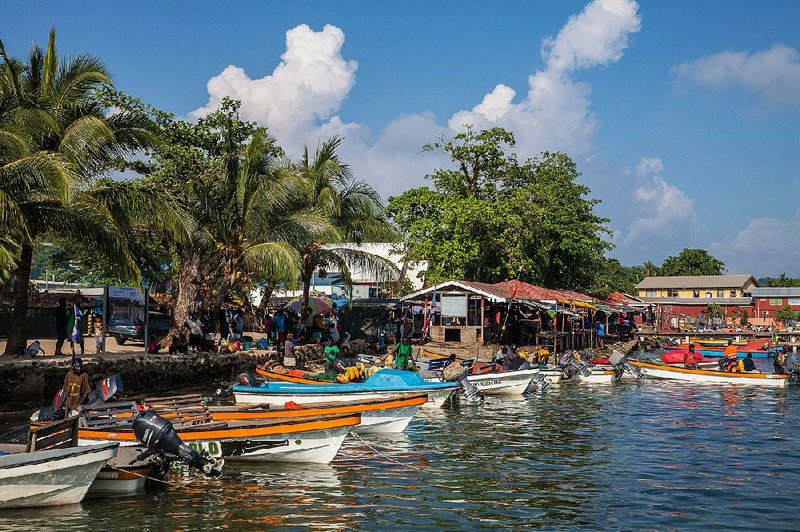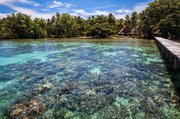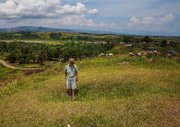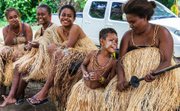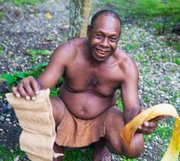HONIARA, Solomon Islands -- If it weren't for the potholes, cavernous pits slowing us down on the road to Honiara, in the Solomon Islands, I might have missed the sign on the tree, "Dolphin View Cottage." But Andrew, our guide, knew the road by heart.
"That's Guyas Tohabellana," he said, waving at a stocky, dark-skinned man in rumpled shorts, a faded T-shirt and flip-flops. "He works here in Guadalcanal. C'mon, let's say hello."
Beyond the bungalow, Guyas' two teenagers lounged on a picnic table, playing with their pet cockatoo. Behind them the beach sloped down to Iron Bottom Sound, the World War II graveyard where 50-odd American and Japanese ships lie at rest. Across the water, Savo Island shimmered on the horizon.
For a couple of minutes, the two men chatted, speaking Pijin so quietly I couldn't make out the words. Then Guyas turned to me and we shook hands.
"You're from America!" he said, switching to English and lighting up. "Do you like it here? Have you been to Gizo and seen the beautiful coral reefs? Yes, my grandfather was a coast watcher during World War II, a spy you'd say, reporting Japanese movements to the Americans. He watched the battle of Savo Island from right here."
A name and a handshake are de rigueur in the Solomons, deep in the South Pacific. Being American counts, too, especially here, where 5,800 Americans were killed or injured fighting the invading Japanese.
"We're known for two things," said Ellison Kyere, from the tourist office, when my partner Steve and I met him for lunch at the Lime Lounge Cafe in Honiara. "For the battle sites and for scuba diving, under the water. It's time to tell the story of island life on land."
A tall order, indeed. The islanders, mostly Melanesian, are scattered over 347 of the country's 922 islands, speaking both Pijin and one of the country's 75 different languages. Some are farmers; some work for the government. Some wear grass skirts and use shell money for barter; others are proud to count headhunters among their ancestors. A few own speed boats; most paddle to market in a "mola," a homemade dugout canoe.
We took the overnight Fiji Airways flight from Los Angeles to Fiji's Nadi airport, changed planes, then flew on to Henderson International Airport, in Honiara, the capital city. I'd brought my phone so I took advantage of the airport's "tourist special," a SIM card good for 75 minutes, for just U.S. $1.30. And we booked a guide for the next day's city tour.
We were still jet lagged the next morning when Andrew pulled up in a shiny black SUV. "All our cars are Japanese and they're all second-hand," he apologized. "Never get new ones. And the Japanese are building an overpass and paving the street and it's taking forever," he added as we inched along past grimy storefronts and vegetable stands overflowing with greens, tomatoes and squash.
"That one, where everybody shops, is owned by a Chinese company," he said, nodding at a big-box department store, the kind we've seen in other third-world countries, there to pave the way to building and mining contracts.
I looked for something I could brag on -- an American-built hospital or a college -- but we'd already turned away, heading to the Memorial Garden cemetery, the American War Memorial and Bonegi Beach, famous for wreck dives. "That's Bloody Ridge," Andrew said, parking the car on a grassy hump of land.
Standing there, imagining the chaos of battle, it felt unreal to be gazing out over sleepy fields while at my feet, still visible, were the foxholes where 40 U.S. Marines died.
The trip -- now nicknamed "Solomons 101" -- began in earnest when we flew north to airfields at Gizo, on Ghizo Island, and Munda, on New Georgia, both in the Western Province, the gateway to equatorial rain forests, volcanic mountains, blue lagoons and sandy beaches.
Met by a skiff and driver, we were off, speeding over a shimmering blue lagoon, to Fat Boys Resort, an all-inclusive, palm-thatched lodge built over deep water, with five bamboo-walled guest bungalows perched on the shore. Our base camp for the next few days, the lodge was a short boat ride to Kennedy Island, where we went ashore to see where Lt. John F. Kennedy and his PT-109 crew hid after a Japanese vessel sank their ship. And close enough to a string of shallow reefs to spend a couple of hours snorkeling, before landing for a grilled-lobster picnic.
"The rising ocean is washing the island away," said Sam, the boat captain, when I asked why one of the trees, its roots submerged in saltwater, seemed to be dying. "People used to think the trees had a disease," he told me. "Now they know it's global warming."
It was party time the next day at Gizo's Friday market. Families in dugout canoes docked at the waterfront, buyers crowded the aisles, coins changed hands, sellers hailed their friends and old ladies filled their shopping bags. Everyone smiled, asking where we were from and posing for photos.
Ngali nuts -- the holy grail of snacks here in the islands -- were in season, so I stocked up with a half-dozen folded-leaf packages. Green taro leaves competed with slippery spinach (Malabar spinach), purple bananas, carrots and betel nuts, commonly chewed here, an affordable substitute for coffee or cigarettes.
"What do they taste like?" I asked an older man with red-rimmed eyes (the clue), who offered me a seat in the shade. "Do they make you feel relaxed?" I ventured to ask.
"Oh, no, they give you energy!" he said, smiling, showing me how he folded the nut and leaf together with a pinch of slaked lime (ash from burned clam shells). "One or two of these and I want to get up and work all day."
Flying on to Munda, on our next leg, we checked into the Agnes Gateway Hotel, on the waterfront, a spartan set of rooms and cottages advertised in scuba magazines. Signing up for a tour to Skull Island, we met boat captain Billy Kere, 30-ish and friendly, and a "descendant of the Roviana headhunter clan," as he told us. Heading for deep water, pounding over incoming waves, we finally docked at tiny Skull Island, just big enough to hold piles of rocks and rows of ancient skulls, victims of long ago battles.
"Don't worry, the headhunters are gone," said Billy, chuckling. "It's all about love nowadays. But not then," he added. "If you sinned? Your head came off."
Going on to Lubaria Island, the PT-boat base where Kennedy and his crew were stationed during the war, we went ashore to visit the barracks and look at the monument. Ata, the keeper, produced a carved wood bust of the youthful Kennedy, which he hides at night. "It's been stolen and recovered twice," he said, leading me to a group of rusty cannons. The real surprise was the modern bathroom.
Two days later, as our adventure wound down and we boarded a 16-seat Twin Otter for the flight back to Honiara -- an aerial tour over islands, bays, coral reefs, rain forests, volcanoes, waterfalls and mountains -- I suddenly realized how much we'd missed. The Solomon Islands, spectacular, varied and pristine, with an annual visitor count of just 24,000, remains one of the world's last untamed destinations (visitsolomons.com.sb). The roads aren't awfully good, especially in the country. But potholes or no, we'll be going back.
Travel on 10/07/2018
